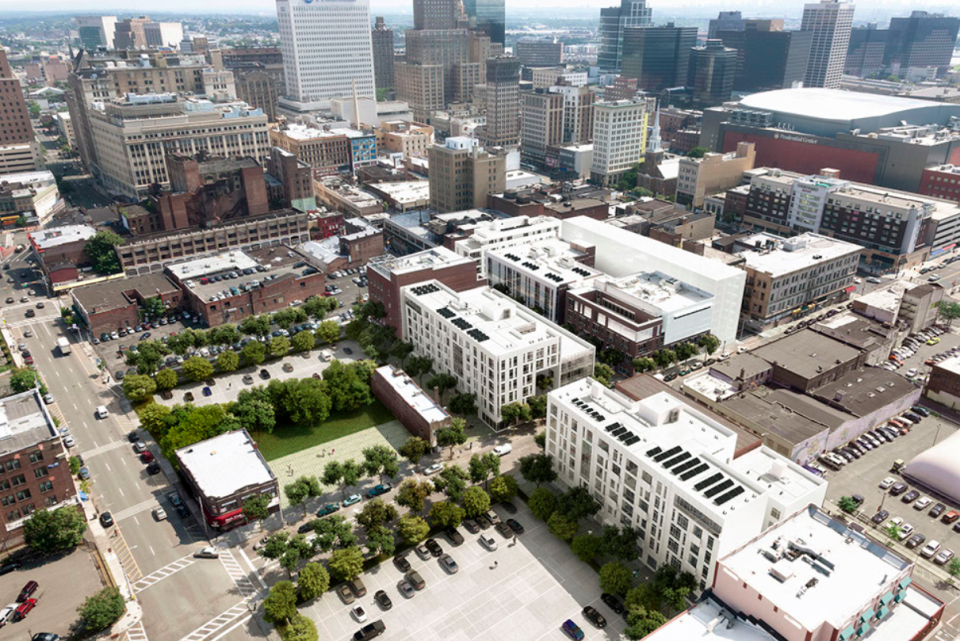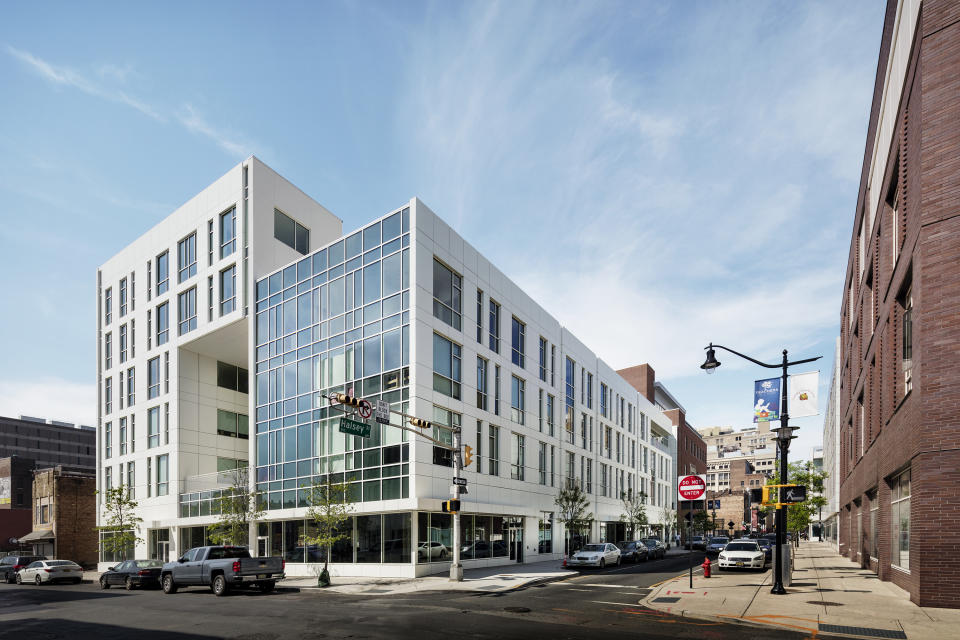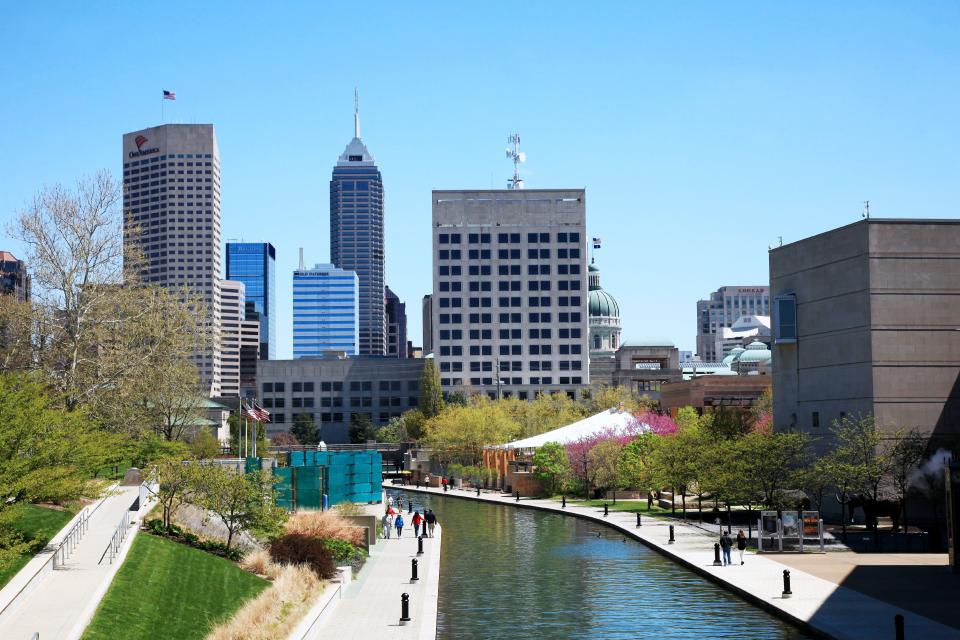There’s a brilliant $150 million ‘Teachers Village’ in Newark

There’s a luxurious 400,000-square-foot complex in downtown Newark with a consignment store, nail salon, fitness center and cupcake shop. At first glance, it might appear to be a glossy page out of a playbook to revitalize the city.
But, the former parking lots were transformed with a very specific demographic in mind. The six buildings actually make up Teachers Village, a new development of three charter schools, a daycare facility, residential apartments marketed to and subsidized for teachers, and retail space that accommodates 20 different businesses.
“I love being around other educators because we can share stories, talk, and learn from each other. One of my neighbors is the head of the Essex County Community College. We’ve been able to work out some things with my middle school kids, introducing them to the idea of college. It’s nice to have this kind of pipeline,” she said. “Plus, the gyms are really nice,” said Irene Hall, Principal of Discovery Charter School, who lives at Teachers Village.
The $150 million, five-year-long project is the brainchild of Ron Beit, founding partner and CEO of Newark-based RBH Group. Having previously focused on commercial and residential projects across Newark, Beit first started playing around with the idea of a Teachers Village in 2007.
“We had a front row seat to the struggles that teachers were facing. We saw that teachers were coming to teach from all over the region, and I got inspired. Once we scratched beneath the surface, we found that only about 15% of teachers lived in Newark,” Beit told Yahoo Finance.
With the help of state tax credits and investments from high net worth individuals and institutional investors like Goldman Sachs, TD Bank and Prudential, RBH Group embarked on a mission to create a space where teachers could live comfortably without feeling burdened by the cost.
Reduced rates for teachers
Teacher’s Village has 204 residential units ranging from studios averaging at $1,000 per month to two-bedrooms that go for $1,900 a month. Seventy percent of the rooms are specifically reserved for teachers and priced 10%-15% cheaper than the aforementioned market rates.
The remaining 30% of the units are open to all others (who have to pay full price). This was part of the financing arrangement, likely to hedge against too many vacancies and underwhelming demand from teachers.
The outreach extends beyond those who work at the charter schools in the neighborhood. The surrounding area houses six different universities, making up a community of 50,000 people.
The mission was to create a vibrant community that operates 24 hours a day, seven days a week.

“When we first started constructing our master plan, the first phase was thinking through the residential, retail and commercial components. With 92% surface parking lot, how could we create a community? We quickly became fixated on housing for teachers and schools would fit the commercial criteria,” said Beit.
After district schools passed on the opportunity to move their schools into the development, Beit connected with three existing charter schools that needed more space and better facilities. They then built a new early childhood learning center for an additional 1,000 students.
Hall, who lives in a one-bedroom unit, said she’s the only Discovery Charter employee who lives in the Village. She hopes to see more of these communities for fellow teachers. Just like popping down the hallway of your college dorm to chat with a classmate, Hall said she’s been able to collaborate with like-minded folks who are just a few doors away.
“It’s a beautiful space. Before, [Discovery Charter] was in the bottom of an alleyway. While we had fixed it up nicely, this is a major upgrade and a great opportunity. It was a no-brainer, really,” she said. “It brings a lot of attention to the school and we love being a part of this community.”
Addressing the plight of teachers
It’s a universally shared sentiment — educators like Hall are responsible for molding the future minds of America and are therefore invaluable members of society. Yet, they aren’t well compensated.
The average salary of a U.S. high school teacher is $58,030. Middle-school teachers make about $54,720 annually. The average starting salary is closer to $36,000 and often additional degrees or certificate programs are required to earn far beyond that threshold. The vast majority make too much to qualify for low-income housing but not enough to live comfortably.
More than one-third of U.S. households live in rental housing. And while the overall market for renters has started to cool down, Americans aren’t feeling flush with cash.
One-half of all renters, or about 20.8 million individuals, are currently cost burdened, which means more than 30% of their income is used on rent and utilities, according to data from Harvard’s Joint Center for Housing Studies.
“Cost burden is common among lower-income folks, but if you look back at the last few years, that burden has extended up the ladder to moderate-income renters — those making between $30,000 and $75,000 per household,” said Whitney Airgood-Obrycki of Harvard. Among renters who work in the field of education, 22.1% are moderately burdened and 13% are severely burdened.
Of course, teachers aren’t alone in feeling overwhelmed by the cost of living, but they are a group that is hit the hardest, said Stockton Williams, Urban Land Institute’s executive director of the Terwilliger Center for Housing.
“The challenge of housing affordability is that a lot of urban school districts are contending with the real barrier of attracting and retaining teachers. It’s part of a much broader story of housing affordability for big segments of the workforce,” he said.
Retaining talent
According to the Learning Policy institute, 90% of open teaching positions are created by teachers who leave the profession. One-third of teachers are retiring, but the other two-thirds leave for other reasons.
“In the high cost urban areas, there’s evidence that the sheer cost of living near these schools is one major reason teachers leave the profession,” said Williams.
And projects like Newark’s Teachers Village are the first step toward providing a practical solution that ultimately helps schools attract and retain talent.

“If urban school districts and individual schools are motivated to keep teachers, they need to enable as many as possible to live near the school. If there are a wider array of housing choices, it’ll help with recruiting new teachers,” he pointed out.
On paper, teachers appear to have it easy with short work days and summers off. In reality, teachers are stretched thin with limited resources and have to put in hours before and after school to make lesson plans, grade papers, attend development trainings, and meet with parents.
“So many teachers work many more hours, on the weekends, early in the morning, late at night. The most dedicated teachers are at the school round the clock. By offering closer housing choices, this makes their lives a little bit easier,” said Williams.
Is this a scalable model?
While Newark’s project is the largest to-date, teacher neighborhoods have been sprouting up across the country over the last few years.
In Baltimore, a former tin can manufacturer has been gutted and transformed into 40 units for teachers, complete with exposed brick walls and bamboo floors.
Last year, the city of San Francisco committed $44 million in public funds toward building 100 to 150 affordable housing units for teachers.
Indianapolis’ school house block
In Indianapolis, a small nonprofit, Near East Area Renewal (NEAR), is working to get teachers on the path toward homeownership. Collaborating with Mayor Joe Hogsett, who ran for office in 2015 promising subsidized housing for teachers, NEAR worked with several contractors to break ground on the project in November. The organization received $2.6 million through a housing partnership with the city and a $500,000 grant from the U.S. Department of Housing and Urban Development.
The project includes 24 houses that will be rehabilitated or built in a two-block area in St. Clair Place, a neighborhood just east of downtown Indianapolis. Homes will be priced between $130,000 and $180,000. The median value of a home in Indianapolis is $142,300, but NEAR Executive Director John Franklin Hay said houses in St. Clair skew higher and are selling in the $200,000s.
There are two layers of income restrictions — teachers who make less than 120% of Marion County’s median income ($58,000 a year for a single person) are eligible to purchase half of the homes; those who make less than 80% of the county’s median income ($39,000 a year for a single person) can apply to buy the other half.

“Most of Indy’s public schools are within a 3-mile radius of downtown. Teachers can’t afford to live anywhere near downtown. They can’t find safe or adequate housing and have to go way out in the suburbs, driving one and a half hours each way. That’s the perspective we’ve heard,” Hay told Yahoo Finance. “Our interest is in helping teachers plant their roots here and to make it a great place to live.”
Teachers are required to live at their homes for a minimum of five years and will be fined if they sell or transfer the property before then.
The first homes will be available in April, and so far, 120 teachers have attended information sessions and expressed interest, and 13 have submitted applications.
Coming to a city near you?
After its success in Newark, RBH Group is venturing outside New Jersey to develop similar residential units for teachers across America. Beit has even trademarked the name Teachers Village. Currently, RBH has two projects under construction — one in downtown Hartford, Conns., and one in East Humboldt Park in Chicago. Neither development incorporates schools in the complex like the one in Newark.

“Having schools is not a traveling part of our model. But there will be a value-added component at each of our Teachers Villages. We’ll offer all kinds of coursework for the communities that we build in. Our vision is that you can sit in a European-style piazza, sipping on a cappuccino and learn in one space,” said Beit.
In each new market, RBH Group is working with local developers to help with occupancy, design, construction and financing.
“We always looked at this as a dual mission project — community impact with respect to recruiting and retaining teachers, but the other aspect is to catalyze economic development,” said Beit.
Melody Hahm is a senior writer at Yahoo Finance, covering entrepreneurship, technology and real estate. Follow her on Twitter @melodyhahm.
Read more: